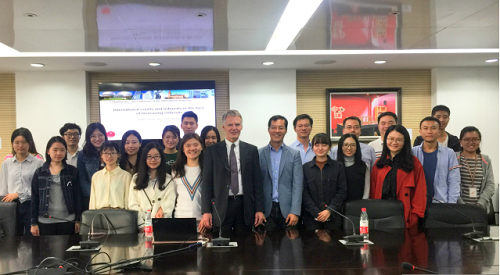Wang Tieya’s International Law Lecture at Peking University on “International Court of Crisis under Increasing” Successfully Held
Date:2018-10-30
On the afternoon of September 28th, 2018, the International Courts and Tribunals in the Face of Increasing Criticism was successfully held in the 307 conference room of the Koguan Building of Peking University Law School. This time, Geir Ulfstein, Professor of International Law at the University of Oslo, Norway, was invited as the keynote speaker. Ulfstein's visit to Peking University's series of courses was supported by Peking University's overseas famous projects.
Professor Ulfstein is currently the President of the Norwegian Institute of International Law. Co-editor of the series “Studies on Human Rights Conventions” and “Studies on International Courts and Tribunals” published by Cambridge University Press, in the Law of the Sea, International Environmental Law, International Human Rights Law He has written extensively in areas such as international organization law.

Professor Ulfstein first introduced the development of the International Tribunal and the criticism it faced. Since the end of the Second World War, international courts have not only achieved rapid growth in quantity, but also in the field of nature and adjustment. When a country accepts a multilateral convention in a certain field or joins an international organization, it often accepts the jurisdiction of an international court established in the constitution of the organization. However, the criticisms of international courts have increased in recent years. These criticisms include: First, international law and the fragmentation of international courts have caused conflicts between different courts to conflict. Second, when the state accepts the jurisdiction of an international court, it has made an agreement to restrict its national sovereignty. However, when international courts explain this restriction on sovereignty, the interpretation criteria are mixed. Third, the independence of international courts has been questioned. On the one hand, large countries and powerful countries may have an impact on the outcome of international court decisions; on the other hand, some international courts may be too independent to break away from the claims of the dispute-solving body, that is, the state, and then turn into a lawyer's law. Fourth, some countries consider individual international courts to be biased and selective in the acceptance of cases. For example, the International Criminal Court has been paying attention to the situation of African countries throughout the year. Fifth, the dispute settlement is too judicial and ignores the alternative dispute resolution mechanism.
Professor Ulfstein suggested that to solve the above problems, it is necessary to consider the justification of the international court. Judging whether an international court is justified requires consideration of four aspects: what the State agrees; whether the court procedure meets the standards of a general constitution or public law; the relationship between the procedures of an international court and domestic court procedures; and the court should A distinction is made between a problem, a fact, and a normative.
In the face of criticism, various international courts have responded to varying degrees. First, as far as the fragmentation of the International Tribunal is concerned, Professor Ulfstein believes that the division of power between international tribunals should be considered. This includes both horizontal and vertical divisions. The International Tribunal as a judicial dispute resolution body should consider its relationship with political settlement agencies. For example, in the Lockerbie air crash case, does the International Court of Justice have jurisdiction over Security Council resolutions? Is the judgment of the International Criminal Court and the UN Security Council exempting state officials? In terms of vertical division of power, it is necessary to consider the division of power between international courts and regional courts, as well as the division of power between international courts and domestic courts. For example, the European Court of Human Rights has developed legal techniques for domestic freedom of judgment to resolve the relationship between the European Court of Human Rights and the domestic courts of the State party. Such a vertical relationship is also reflected in the interpretation of the supplementary jurisdiction of the International Criminal Court: the International Criminal Court can only accept the case if it is unwilling or unable to govern a case.
Second, in order to ensure the independence and impartiality of international courts, different courts have adopted different systems. The International Court of Justice allows judges to express separate opinions and objections, rather than merely “submission” to the majority opinion. The European Court of Human Rights extended the term of judges from six years to nine years to prevent judges from losing their impartiality in order to please the parties in order to obtain votes. In addition, third-party intervention systems, non-state entities and other expert witness systems will also affect the independence of international courts. Thirdly, in the case of alternative dispute resolution mechanisms, the International Court of Justice is obliged to report to the United Nations General Assembly and the Conference of the Parties to the International Criminal Court has the power to hear reports from the International Criminal Court. These are all means of coordinating judicial and political settlements.

During the on-the-spot questioning and communication session, the audience held a discussion with Professor Ulfstein on “possible forms of international cooperation”, “the role of international courts in the field of international environmental protection” and “the different sources of legitimacy of different international courts”.
Translated by: Chen Wen
Edited by: Nie Xudong



